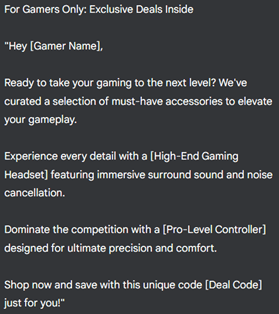Generative AI (gen AI) is poised to unlock between $240 billion and $390 billion in economic value for retailers, according to McKinsey. Currently, those retailers that understand their customer base, launch gen AI products that fit their audience and implement them using a phased approach are satisfied with their progress — but this only accounts for 1% of McKinsey’s retail respondents.
The reason gen AI rapidly gained mainstream adoption after OpenAI’s launch of ChatGPT in 2022 was due to its ability to create novel content (text, images, music) from user prompts. Powered by AI algorithms, it processes vast datasets, while natural language processing (NLP) enables it to understand and respond to user input conversationally.
For retailers primarily targeting Gen Z and millennial consumers — which now make up over 40% of the population — applying gen AI in the research phase of the purchase journey is a good place to focus attention. A recent Vogue study found that 70% of Gen Z and 69% of millennials only trust a brand after carrying out their own research. What research do they do? Compare prices on Amazon (48%), look for special offers (45%) and check the item out in the store (44%).
Many gen AI applications can advance a retailer’s consumer-facing experience; let’s examine some use cases that support these three consumer research areas.
Making Price Comparisons Easier
Although 21% of consumers may have splurged on themselves when shopping for clothes last year, once the $100 inflection point was reached, the details that justify the price become much more important.
Price has been a top driver for many consumers for decades. Accordingly, over the years, retailers have prioritized monitoring competitor prices to ensure they continue to thrive. Pairing this competitor pricing analysis with consumer-facing generative AI allows consumers to easily discover if there is a better price out there.
Rather than sending customers away from e-stores to price comparison sites — which are never fully representative, as fabrics, colors and locality factors vary, for example — customers can talk with retailers’ virtual shopping assistants. When retailers regularly update gen AI-powered chatbots with competitor and product data, shoppers can ask and learn about products to better understand their value. This satisfies Gen Z shoppers that are looking to justify their purchases and buy from retailers that meet their digital-native, value-driven needs.
Give Them the Offers They Need
Whether online shoppers are buying dental implants, fitness accessories or items for the house, they have their own conditions and styles. However, finding the right categories and filters can be time-consuming and, in some cases, confusing for shoppers. Conversational chatbots help retailers get to know their customers better by engaging in two-way communication to understand their specific interests. When securely stored, this conversational data empowers businesses to authenticate customers seamlessly and deliver highly personalized offers.
On the back end, retailers can employ gen AI to help recognize patterns in customer shopping history and use it to support the crafting of personalized emails at scale. Perhaps a retailer embeds a user interface that enables team members to ask prompts like, “What are most shoppers clicking on today?”

Let’s say the chatbot finds many customers interested in gaming consoles and accessories. Retailers can use this information to create unique promotions in real time. They also can use gen AI to tailor email subject lines, product recommendations and compelling narratives according to the customer, or design personalized on-site promotions such as banners, pop-ups and product recommendations.
Increasingly, retailers and their marketing teams will be able to use gen AI to analyze conversations, purchase history and product data; find the most relevant items; and draft the content. This saves marketing teams tons of time, allowing them to simply edit and approve pre-written content and send personalized promotions at scale.
Save Time NOT Going to the Store
Virtual try-on is increasing in popularity. Google is one example of a platform that uses gen AI so that shoppers can choose to see items of interest on a wide selection of models.
Returns are a hassle for fashion retailers, costing a projected $890 billion in 2024, and a source of disappointment to customers. Over 40% of items are returned due to size issues — both in the apparel and footwear categories — with other common reasons including items were not as described or didn’t meet expectations.
Whether buying clothing or household goods, customers struggle to rely on their online representation. However, where there have previously only been a few images of furniture in one particular room, or perhaps not in a room at all, now AI is helping demonstrate these items at scale. Retailers can AI-generate product images to give consumers a better idea of what products look like in multiple different spaces, no matter the color, size or wallpaper they choose.
Google’s gen AI tool demonstrates how retailers can take one image and accurately reflect how different fabrics would “drape, fold, cling, stretch and form wrinkles and shadows on a diverse set of real models in various poses.” The same can be said for furniture.
Gen Z and millennials will continue to compare prices, look for special offers and try items before buying them to avoid costly returns. Gen AI can be a powerful tool to give retailers a competitive edge and make these processes seamless for customers without the need to leave the retailer’s website. By pairing competitor analytics, email marketing tools and customer and product data with gen AI, retailers can create powerful AI shopping experiences for their audiences.
Nate MacLeitch is a highly experienced business professional with a diverse background in industries such as telecom, media, software and technology. He began his career as a Trade Representative for the State of California in London and has since held key leadership positions, including Head of Sales at WIN Plc (now Cisco) and COO at Twistbox Entertainment (now Digital Turbine). Currently, he serves as the CEO of QuickBlox, a leading AI communication platform. Beyond his work experience, Nate is actively involved as an advisor and investor in startups like Whisk.com, Firstday Healthcare and TechStars.




